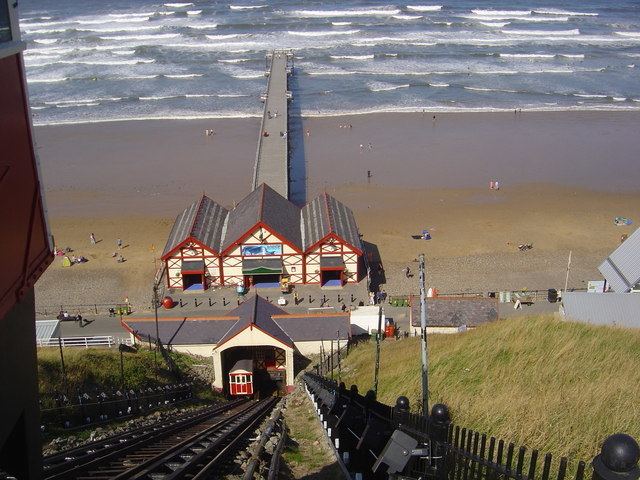Transit type Funicular railway Began operation 28 June 1884 System length 63 m | Number of stations 2 Phone +44 1287 622528 | |
 | ||
Track gauge 4 ft 8 ⁄2 in (1,435 mm) Hours Closed now Friday11AM–5:30PMSaturday11AM–5:30PMSunday11AM–5:30PMMonday11AM–5:30PMTuesday11AM–5:30PMWednesday11AM–5:30PMThursday11AM–5:30PMSuggest an edit Similar Captain Cook & Staithes, Saltburn railway station, Cleveland Ironstone Mining M, British Steel Redcar ra, Longbeck railway station | ||
Saltburn cliff lift
The Saltburn Cliff Lift is a funicular railway located in Saltburn-by-the-Sea, Redcar and Cleveland and the ceremonial county of North Yorkshire, England. It is the oldest operating water-balance cliff lift in the world.
Contents
- Saltburn cliff lift
- Saltburn cliff lift 2011
- Cliff hoist 18701883
- Cliff lift 1884present
- Operational theory
- Operations
- References
Saltburn cliff lift 2011
Cliff hoist 1870–1883
The Stockton and Darlington Railway arrived in Saltburn from Redcar on 17 August 1861, prompting a growth in day and holiday travellers. Like many seaside resorts, this created a local business initiative, resulting in various pieces of construction, including the Saltburn Pier completed in 1869. Access to the pier from the town via the steep cliff top was difficult, so a solution was sought.
The Saltburn Pier company contracted John Anderson to engineer a solution, which was the wooden Cliff Hoist. Allowing up to 20 people to be placed in a wooden cage and then lowered by rope to beach level, it opened on 1 July 1870, some 14 months after the opening of the pier. Approaching the hoist from the town by a narrow walkway, the passengers then descended 120 feet (37 m), after water had been added to or taken away from a counterbalance tank.
Cliff lift 1884–present
After the pier company was sold to the Middlesbrough Estate in August 1883, the new owners had the Cliff Hoist inspected by independent engineers, who condemned it due to numerous rotten timbers. The Cliff Hoist was therefore demolished in late 1883.
They commissioned Sir Richard Tangye's company, who had built the two earlier vertically inclined water powered funicular railways in Scarborough, to build a replacement. Tangye had appointed George Croydon Marks head of the lift department, in which role he was in charge of the design and installation at Saltburn. Marks designed and constructed a funicular with a height of 120 feet (37 m) and a track length of 207 feet (63 m), creating a 71% incline.
Operational theory
The two 12-person cars are each fitted with a 240-imperial-gallon (1,100 L) water tank, and run on parallel standard gauge 4 ft 8 1⁄2 in (1,435 mm) funicular railway tracks. Double steel wire ropes are attached to both cars, controlled by a brakeman in the upper station. The car at the top has its water tank filled until its mass exceeds the mass of the car at the bottom. It then travels down the incline, counterbalanced by the mass of the other car, which travels to the top, with the brakeman controlling safety and the speed of travel. When the car reaches the bottom, its water is released thus reducing the mass of the lower car, and pumped back up to the top of the cliff.
Operations
It is believed that the Cliff Lift opened on Saturday 28 June 1884, but there was a period of inconsistent operation at the start. The opening of the Cliff Lift allowed the pier company to undertake an extension to that structure.
The original cars, capable of seating 10–12 passengers, had stained-glass windows. But when the Cliff Lift was refurbished in 1955, the car bodies were replaced without these. The wholly new aluminium cars were introduced in 1979, modelled on the original design. The stained-glass windows were reinstated in 1991. The wooden bodies of the passenger cars were fully refurbished and "victorianised" in 2011 by Stanegate Restorations of Haltwhistle, Northumberland.
Owned since the Second World War by the local council, Marks's design was so good that, beyond maintenance and refurbishment, little has changed since 1884. In 1924, the current AC electrically operated water pump was installed replacing the 1913 DC generator & pump that itself replaced the original town gas four-cylinder Crossley combustion engine driven pump, and in 1998 the main braking wheel was replaced for the first time, together with the installation of a new hydraulic braking system to complement the original band braking/driving system. In the spring of 2014, a full refurbishment of the top station was carried out returning it to its original design.
